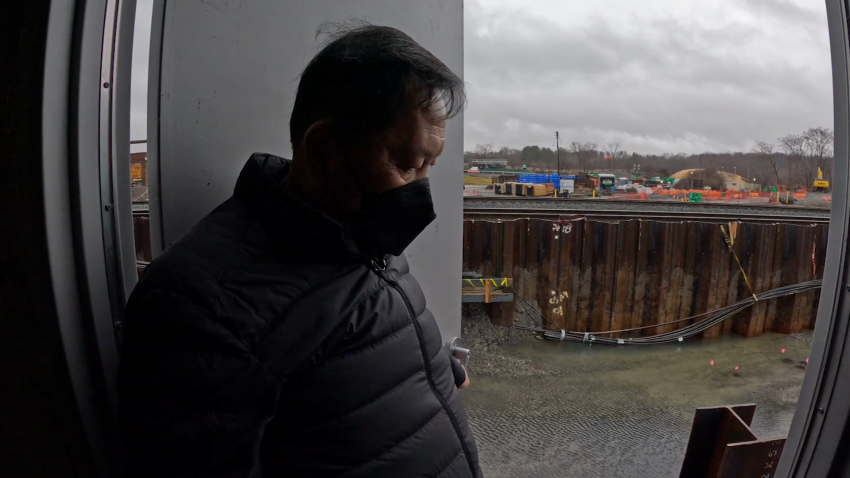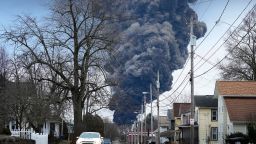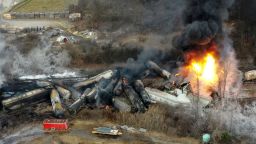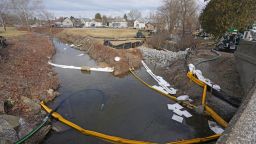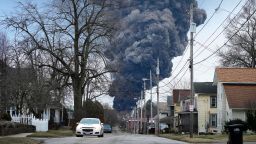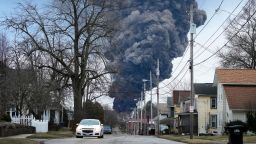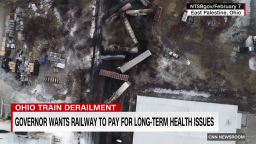When government officials lifted an evacuation order for people who lived near the site of a train derailment and toxic spill in East Palestine, Ohio, last year, many homes held on to an odd odor.
It was a sickly-sweet smell, and it evoked comparisons to paint thinner, but fruitier, or maybe potpourri mixed with old perfume.
To reassure residents, the train’s operator, Norfolk Southern, and the US Environmental Protection Agency offered to check the air in homes for chemicals.
More than 600 households signed up. What they didn’t know was that the handheld devices used for the screening couldn’t detect one of the main chemicals spilled from the train — butyl acrylate — at levels that could irritate the eyes, nose, throat and lungs.
Case studies of people exposed to butyl acrylate in previous spills have raised questions about whether brief exposures may lead to longer-term health problems.
“I would say this is one of the most significant errors associated with the response,” said Dr. Andrew Whelton, an environmental engineer at Purdue University who has done independent testing in East Palestine. “It’s because of this so many people were chemically exposed when they returned.”
Although the EPA and Norfolk Southern’s contractor, CTEH, understood the limitations of the machines, they carried on with the home testing, according to an air testing plan drawn up by CTEH. They relied on smell to pick up on the presence of butyl acrylate at lower levels — although residents weren’t told that odors could indicate chemical exposure, according to an EPA official who answered questions on behalf of the agency on the condition that they not be named.
By the time the EPA adopted a more sensitive test and a lower standard for butyl acrylate, the home screening was nearly complete. People who’d had their homes checked weren’t told about subsequent adjustments to the air testing program and why they were made, according to CTEH and the EPA. They were never offered more indoor air testing.
“I had no idea,” said David Chick, who lives about a quarter of a mile from where the train wrecked and caught fire.
Chick thinks that few people in the village are aware of what happened and that confusing messages from the EPA have probably fueled division and distrust in the community. “The dynamic around town would be completely different if even 60% or 70% of the people knew that,” he said.
‘One hell of an irritant’
Butyl acrylate was one of a stew of toxic chemicals released into the soil, air and local waterways after a Norfolk Southern train flew off its tracks and caught fire on February 3, 2023, damaging at least 11 cars carrying hazardous materials, according to the EPA.
Two of the cars that derailed had been holding nearly 386,000 pounds of acrylates, strong-smelling, highly irritating chemicals that are used to make paints, coatings, caulks and sealants.
Many people know the olfactory assault of acrylates from nail salons, since some types of nail polish and nail products use them.
Two acrylates were spilled in East Palestine: butyl acrylate and ethylhexyl acrylate.
Surface water testing by the Ohio EPA found sky-high levels of acrylates in local creeks in the first few days after the derailment. Those levels tapered off and are undetectable now, based on recent testing, but the chemicals were still detectable in Sulphur Run through March 2023.
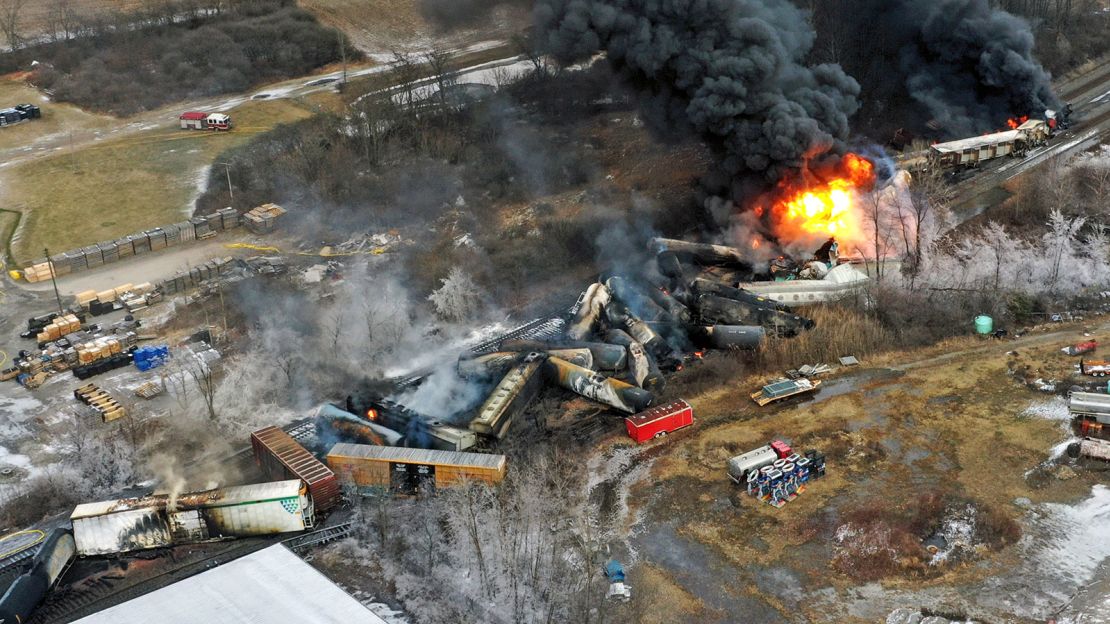
It’s not clear how much butyl acrylate people were exposed to or for how long. Environmental health experts note that because of a number of factors, including age and underlying health conditions, there’s a wide range of individual sensitivity to chemicals. In other words, different people will react to chemicals at different levels.
The EPA says its ongoing testing shows that people are not currently being exposed to chemicals from the derailment in their homes.
Independent air testing conducted in September by the University of Kentucky and Wayne State University backs that up. In 15 buildings where air monitors showed consistently high levels of volatile compounds, researchers hung sensitive air sampling badges, which use charcoal to absorb chemicals from the air, to find out exactly what was causing the readings to be high.
Some homes had higher than expected levels of chemicals that can be found in vehicle exhaust or in solvents used in dry cleaning.
In three buildings, researchers detected traces of butyl acrylate. The levels were so low, however, that researchers said they couldn’t be confident in the numbers. They also noted that butyl acrylate is in a lot of common products, like paint and caulk. Because butyl acrylate is unstable in the environment, they say, it’s highly unlikely that what they measured is from the derailment.
But that doesn’t mean people in East Palestine were never exposed to acrylates, said Dr. Erin Haynes, chair of the Department of Epidemiology and Environmental Health at the University of Kentucky, who led the study.
In the first few weeks after the spill, more than 90% of 702 people in the area who answered a government health survey reported having headaches, and more than 70% reported coughing or burning eyes. Stuffy noses, dizziness and breathlessness were also common, as were new or worsening mental health problems.
Health officials said the symptoms reported in the survey were consistent with the known health effects of the chemicals that were on the train.
“Butyl acrylate is one hell of an irritant, in my limited experience with it,” said Dr. Alan Ducatman, a former professor of occupational and environmental medicine at the West Virginia University School of Public Health and former director of the Environmental Medical Service at the Massachusetts Institute of Technology.
Ducatman treated people who were exposed to butyl acrylate after a tanker truck carrying nearly 45,000 pounds of the chemical collided with a logging truck in Bristol, West Virginia, in 1998. Both vehicles exploded on impact, killing their drivers.
The wreck shut down a four-lane highway and forced the evacuation of people living half a mile around the site, according to news reports and interviews with residents who remember the incident. Nearly two dozen people were known to have been treated for chemical exposure related to the spill. Six were hospitalized.
In 2012, Ducatman co-authored a case report on three people who had lasting problems from their exposures. Outside of East Palestine, Ducatman believes, this small study is the only documented exposure of health effects after an environmental spill of butyl acrylate in the US.
“They weren’t getting better as quick as their doctors told them they should, so they came to us,” he said.
In one case, a college student who got stuck behind the wreck in her car and sat in the fumes for about half an hour came to Ducatman two weeks after the accident with a swollen face and a persistent cough, despite being prescribed steroids during a previous visit to an emergency room.
“It was just the most hacking, dry, unpleasant cough. It was a wracking cough,” Ducatman said, adding that he and his fellow physicians could tell when they were getting someone else who’d been exposed to butyl acrylate. “We’d say ‘OK, there’s another one.’ Because you could hear them coming down the hall.”
Another patient in the case report was a landfill worker who’d handled contaminated dirt from the accident site over several days. He was diagnosed with chronic bronchitis.
The third patient was a first responder who’d helped evacuate residents around the accident site. Exposure to butyl acrylate had sensitized his airways so they became easily irritated, and he began having asthma attacks. Seven months after the accident, in addition to breathing problems, he complained of muscle pain and weakness and brain fog.
Ten years after the accident, he was still taking medication for asthma he didn’t have before the spill.
Most people exposed to the chemical in West Virginia got better over time, Ducatman said, “but for at least one of these patients, it was a life-changing event.”
Questions about indoor air testing
In East Palestine, technicians from CTEH and the EPA came to houses with handheld devices that measured levels of a broad class of chemicals called volatile organic compounds, or VOCs. Butyl acrylate is a VOC.
Even as home screening got underway, the EPA reached out to scientists at the Agency for Toxic Substances and Disease Registry, or ATSDR, part of the US Department of Health and Human Services, for help to establish what the agency calls minimal risk levels for butyl acrylate, according to the EPA official.
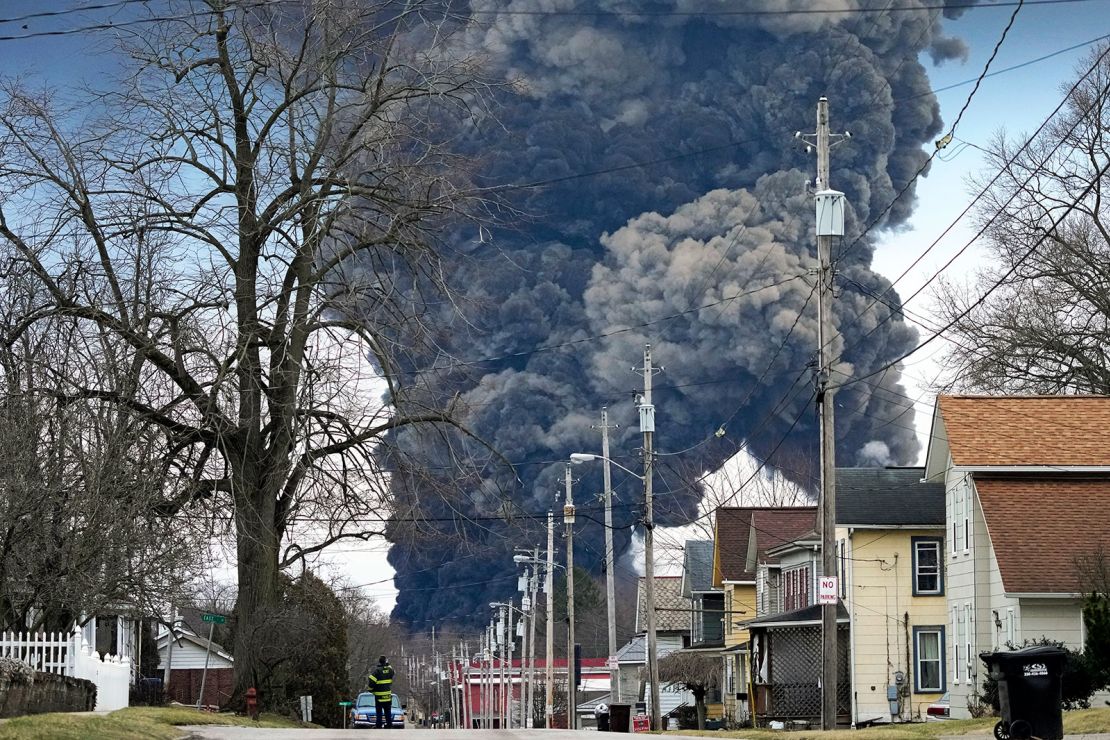
Minimal risk levels are the amount of a chemical a person could breathe, eat or drink in a day without experiencing health effects, besides cancer. Risk levels for chemicals known to cause cancer are generally even lower. Health officials say there’s not enough research on butyl acrylate to know whether it’s a carcinogen.
In some cases, ATSDR has set minimal risk levels for chemicals. There weren’t any for butyl acrylate, according to the EPA, so experts at the agency set to work creating them.
“These levels were based on an exhaustive review of relevant scientific literature and subject matter expert input,” ATSDR said in an emailed response to questions.
With residents eager to return to their homes, the ATSDR’s experts had to work quickly.
On February 7, they proposed a two-week action level for butyl acrylate of 3,300 parts per billion (ppb). The evacuation order was lifted on February 8, and testing of homes got underway later that evening.
On February 9, after further study, ATSDR revised that number, advising that the two-week action level should be 66 times lower: 50 ppb, according to an EPA official.
Parts per billion is a way scientists express the concentration of chemicals in air or water. It’s a tiny amount. Using Earth’s population as an example, a single part per billion would be eight people on the entire planet. So ATSDR’s initial action level for butyl acrylate, 3,300 ppb, would be like 26,400 people out of the entire population of the Earth, while the proposed level of 50 ppb would be just 400 people out of that number.
The ATSDR scientists were concerned because of butyl acrylate’s sensitizer effects, according to the EPA official. Sensitizers prime the body so future exposure to even small amounts may provoke an allergic reaction on the skin or respiratory tract.
ATSDR proposed the 50 ppb safety threshold for butyl acrylate two separate times, according to background in the air testing plan drawn up by CTEH.
After a discussion with the EPA and CTEH, the 50 ppb level was rejected because the machines being used to do the screening couldn’t detect the chemical until it reached a concentration of about 160 ppb in air, according to background on the decision in an air testing plan written by CTEH.
After noticing discrepancies between the handheld detectors and other types of air testing in use in East Palestine, the EPA studied the devices over the summer. That testing confirmed that the machines couldn’t reliably pick up butyl acrylate at the 20 ppb and 50 ppb levels proposed by ATSDR.
There was a good reason experts wanted that safety threshold. According to the Pennsylvania Department of Health, one of the agencies assisting residents after the spill, butyl acrylate may irritate the eyes, nose and respiratory tract when the concentration in air reaches 50 ppb.
CTEH disputes that, however. According to written answers provided by Dr. Paul Nony, principal toxicologist and senior vice president of the company, the 50 ppb screening level for butyl acrylate “was much lower than concentrations that could cause adverse health effects.”
Instead, the action levels for all chemicals were adjusted down by a factor of 10 to protect more sensitive individuals, such as children. The level for butyl acrylate became 330 ppb, still higher than the level where people might have symptoms.
“During an emergency response, as more information about site exposure duration, site characterization, and more environmental data becomes available, it is not uncommon for screening levels to be adjusted to be protective of human health,” ATSDR said in a written response to questions.
ATDSR also proposed an even lower chronic risk level of 20 ppb for exposures lasting between two weeks and one year. That level was adopted in April, after nearly all the homes had been screened, according to the air testing plan drawn up by CTEH.
All told, the air in 630 homes was screened from February 8 and into April, according to EPA updates.
In most cases, the testing did not detect any VOCs above 100 parts per billion. According to the EPA, if the machines measured any VOCs above that level, homeowners were advised to ventilate their homes by opening windows. About 100 homes with detections of VOCs also had additional sampling but only for vinyl chloride or one of its breakdown products, hydrogen chloride. Tests did not find vinyl chloride or hydrogen chloride in any homes.
What’s more, CTEH and the EPA reasoned that butyl acrylate had such a strong smell that it could be detected by odor alone, so odor became the main way the screening teams checked for lower levels of the chemical.
The adjustment in strategy was never broadly conveyed to village residents, however. Instead, the EPA issued guidance that chemicals from the derailment could be smelled at far lower levels than would cause any health problems, so the presence of an odor was not necessarily cause for alarm.
Outside experts have cautioned that smell may be an unreliable indicator for butyl acrylate, partly because people can become accustomed to odors
“Odor thresholds vary greatly. Do not rely on odor alone to determine potentially hazardous exposures,” says a fact sheet on butyl acrylate from the New Jersey Department of Health.
Ducatman, the doctor who has treated people exposed to butyl acrylate, said it’s clear to him that ATSDR was correct to make its risk levels more protective.
He also said smell should never be the primary way to gauge an exposure to butyl acrylate.
“We already know with irritant exposures that induce asthma, if you smell it, it’s already a problem,” he said. “But if you don’t smell it, it doesn’t mean it isn’t a problem.”
In a statement, ATSDR noted that it did not have input into the air testing plan and did not sign off on it.
The EPA and CTEH maintain that because they were using a “multilayered approach” checking for odors and testing outdoor air, they believe residents were adequately protected, the EPA official said.
A representative for Norfolk Southern did sign off on the plan. The company defended the decision not to use the ATSDR’s proposed 50 ppb risk level.
“The health and safety of the community has been our focus from day one. We are confident the rest of Unified Command shares that focus, and that this decision was made with that in mind,” said Connor Spielmaker, senior communications manager for Norfolk Southern. Members of the Unified Command leading the response include representatives from the EPA, the Columbiana County Emergency Management Agency, the Village of East Palestine, the Ohio EPA and Norfolk Southern.
Keith Drabick, chief of the East Palestine Fire Department and incident commander at the time, did not respond to a request for comment on the decision.
Trying to move on
Lonnie Miller signed up for the indoor air screening for her cherished tan and brown home on East Clark Street in East Palestine, the one that has her son’s baby footprints in the concrete they poured to build the garage.
The home sits about 200 feet from Norfolk Southern’s tracks. Sulphur Run is also nearby. Within hours of the derailment, Miller says, she and her husband began smelling chemicals. They discussed what to do and decided to leave. They returned on February 21, 2023, well after state and federal officials said it was safe to return.
The Millers were told that the indoor air testing found nothing of concern.
“They stated the levels were all identical, just like everyone else’s readings, coming back low,” Miller said.
Despite this, she says, her face broke out in a rash after she returned home in February 2023. She says her nose still burns when she’s there for more than a few hours.
Miller said she had heard that the equipment used to test homes wasn’t adequate to find all the chemicals. She wants the EPA to redo the testing with more sensitive equipment, such as the clip-on badges they now use for outdoor air sampling.
Those badges can detect butyl acrylate in air at levels as low as 9 parts per billion.
The EPA has considered doing more indoor air testing, mostly to increase community confidence, the agency official said. But it concluded that it wouldn’t be a good idea because testing would probably find chemicals from household sources rather than any lingering contamination from the derailment.
The EPA says its extensive outdoor testing has confirmed that there are no “ongoing exposure pathways for contaminants of concern in people’s homes,” according to a statement from EPA Region 5 Administrator Deborah Shore.
Miller doesn’t believe it. “We’ve already been lied to so many times,” she said.
“That episode really burned the trust bridge,” said the University of Kentucky’s Haynes. “They came back like they were told they could, and that testing was done after the fact with poor equipment.”
In a written response to questions, CTEH said that no homeowners were notified about the changes in screening levels or the limitations of the handheld detectors and that no homes were subsequently retested “as the instrumentation used for indoor air assessments achieved detection limits below the screening levels approved by” incident command.
“The instrumentation used by CTEH was sufficiently sensitive to detect levels of butyl acrylate and vinyl chloride at levels that would pose adverse health effects,” said Nony, the company’s senior vice president.
Broken trust
David and Shanna Chick and their two grade-school-age kids live about a quarter of a mile from where the train wrecked and caught fire. David, 32, has lived in East Palestine his whole life.
They had their home tested when Norfolk Southern and the EPA offered the screening on February 10, 2023. They were told that there was no problem, nothing was detected. CNN reviewed their air screening results.
Shanna, 33, works from home. She says the smells and symptoms aren’t as bad as they were in the beginning, but they still come and go.
“There’re days when I go outside, and I’m just walking to my garage, and I can just feel that I’m having a hard time breathing,” she said.
She wants to believe the EPA’s assurances that her family is out of harm’s way, she says, but her body is telling her something else.
“They’re missing something,” she said.
David is the operations manager for CeramSource, a company that closed one of its East Palestine manufacturing plants — Ceramfab — in 2023, laying off about 30 workers. The derailment and subsequent burn of thousands of pounds of vinyl chloride happened almost directly behind the Ceramfab building.
He said contractors hired by the railroad screened the building with one of the handheld devices, a photoionization detector or PID.
“They gave us the all-clear. They said ‘OK, go back to work. You’re fine,’” he said. Air screening results reviewed by CNN show that Ceramfab was tested on February 11, 2023, and nothing was detected.
Workers came back on a Monday, he said. By Wednesday, they were getting rashes and feeling breathless. One person had a nosebleed.
When they tried to bring the workers back again the next week, “it was the same thing all over again,” he said.
Eventually, Ceramfab’s customers stopped placing orders for fear their products would be contaminated, and Edwin Wang, David’s boss, decided to shut the factory down.
David has spent the past few months trying to get the factory packed up and closed. He says his eyes get irritated, his throat gets scratchy, and it’s harder to breathe after spending time in the building. The EPA is testing Ceramfab for vapor intrusion, or chemicals that might have migrated under the foundation of the building through contaminated soil.
When he goes home, which is a bit farther from the site, David says, his symptoms ease.
With a growing family, the Chicks had wanted to move to a bigger house for more space, but the derailment sped up the timeline.
Members of his extended family, which goes back generations in East Palestine, are trying to get out.
“My grandma lives at the top of the hill. My brother lives here. My aunts and uncles all live here,” he said. “We’re all from the area, and everybody’s trying to get out.”
Looking for more help
As time passes, answers will be harder and harder to get. Chemicals will break down in the environment or be metabolized by the body, leaving no immediate trace of where they were or what they did.
“I think, with all the uncertainties about what’s gone on here, that people who want to leave should be given that option, and the federal government should pay for that, and the company should have to reimburse the government,” said Stephen Lester, science director of the Center for Health, Environment & Justice, a nonprofit advocacy group started by victims of Love Canal, a neighborhood in New York where hundreds of people were harmed in the 1970s by the dumping of toxic chemicals.
Lester points out that there is precedent for doing this, for example, with the first responders to the September 11 attacks, with families and soldiers who were stationed at Camp Lejeune in North Carolina and exposed to toxic solvents in drinking water, with Vietnam veterans exposed to Agent Orange.
“All of these places have made a decision about the health problems these people have. And they’ve decided that the science is incomplete, which it is,” Lester said. “There’s no way we can determine, with all the uncertainties and a lack of testing, whether the illnesses people are having in East Palestine were caused by that burn.”
Without enough evidence but with people sick, the government agreed to acknowledge that anyone who was in places like Love Canal and Camp Lejeune was probably exposed and that, if they had certain illnesses after, they should be compensated.
“They should get health care paid for by the government and be given the option to leave,” Lester said.
Lonnie Miller agrees.
Get CNN Health's weekly newsletter
Sign up here to get The Results Are In with Dr. Sanjay Gupta every Tuesday from the CNN Health team.
She and her husband, Dave, recently bought another home about a 20-minute drive away in Leetonia, Ohio, rather than return with their 21-year-old son to their home in East Palestine.
Their East Palestine home has been on the market for more than 130 days. They’ve had only two showings, even though they’ve lowered the price three times.
Her family took the $1,000 inconvenience checks that Norfolk Southern paid to everyone who lived within a certain proximity of the derailment, she said, and accepted some reimbursement for their relocation expenses, but beyond that, she can’t stomach the thought of taking the company’s money.
She refuses even to participate in the program the railroad created to compensate residents for lost value of their homes.
“They put us in this position,” Miller said. “And we’re supposed to go beg them for help? We shouldn’t be put in that position.”
CNN’s Jason Carroll and Sarah Boxer contributed to this report.
